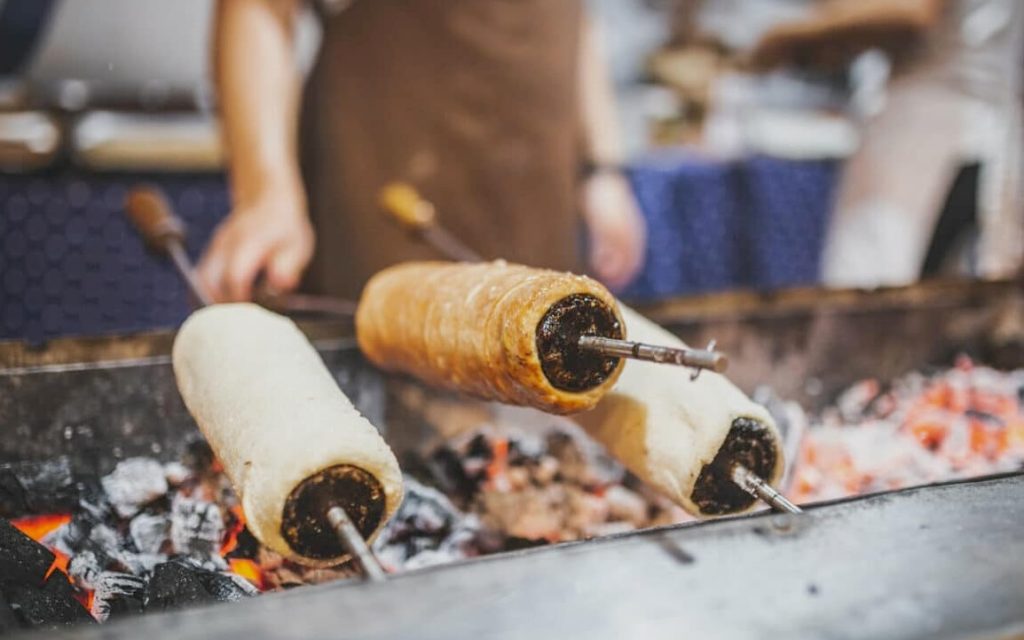One of the sweetest joys of visiting Budapest is indulging in a freshly baked chimney cake, or “kürtőskalács” in Hungarian. This beloved pastry is a staple at festivals, markets, and bakeries throughout the city, enchanting locals and tourists alike with its crispy exterior, soft interior, and tantalizing aroma. Let’s explore the history, preparation, and sheer delight of enjoying a chimney cake in Budapest.
A Sweet Tradition
Chimney cake has deep roots in Hungarian and Transylvanian culinary traditions, with its origins dating back to the medieval era. Initially, it was prepared during special occasions and celebrations, symbolizing warmth and hospitality. Over the centuries, it has evolved into a popular street food, particularly cherished during holidays and festive events.

The name “chimney cake” comes from its cylindrical shape and the steam that rises from it when freshly baked, resembling a chimney. It’s a fitting name for a pastry that brings so much warmth and joy to those who savor it.
The Art of Making Chimney Cake
Ingredients and Preparation
The simplicity of chimney cake’s ingredients—flour, sugar, yeast, butter, milk, and eggs—belies the magic of its preparation. The dough is rolled out into long strips and then wrapped around a wooden or metal cylinder. Once wrapped, it is brushed with melted butter and rolled in granulated sugar, which caramelizes during baking to create a crispy, golden-brown crust.
Baking Process
Traditionally, chimney cakes were baked over an open flame, which imparted a unique smokiness to the pastry. Today, they are often baked in specialized ovens or over charcoal grills, ensuring an even bake and that irresistible caramelized exterior. The baking process is mesmerizing as the dough slowly turns and browns, filling the air with a delightful, sugary aroma.

Flavor Variations
While the classic chimney cake is simply coated in sugar, modern variations have introduced a range of delectable flavors. Once baked, the cake can be further rolled in toppings such as cinnamon, cocoa, crushed nuts, or coconut. For extra indulgence, some vendors fill the center with Nutella, ice cream, or whipped cream, transforming it into a decadent dessert.
Enjoying Chimney Cake in Budapest
Street Markets and Festivals
The best way to experience chimney cake is from a street vendor, where you can watch the baking process and enjoy it fresh off the grill. Budapest’s Christmas markets, such as those at Vörösmarty Square and the Basilica, are famous for their chimney cake stalls. These markets come alive with festive lights, music, and the mouthwatering scent of kürtőskalács, making them a must-visit during the holiday season.
Cafés and Bakeries
For a more relaxed experience, many cafés and bakeries in Budapest offer chimney cake on their menus. Places like Molnár’s Kürtőskalács, located in the city center, specialize in this sweet treat, providing a cozy setting to enjoy it with a cup of coffee or hot chocolate. These establishments often offer a variety of flavors and fillings, allowing you to explore different taste combinations.
A Symbol of Celebration
Chimney cake is more than just a pastry; it’s a symbol of celebration and communal joy. Whether you’re enjoying it at a lively market or a quiet café, the experience of sharing this sweet treat with friends and family is a cherished part of Hungarian culture. The process of tearing off pieces and savoring the warm, caramelized dough is a simple yet profound pleasure that brings people together.
Making Chimney Cake at Home
A Fun Baking Project
If you’re inspired to recreate the chimney cake experience at home, it’s a fun and rewarding baking project. While you may not have a traditional oven or grill, you can use a regular oven and substitute the wooden cylinder with a rolling pin or a similar kitchen tool. The key is to ensure the dough is wrapped evenly and baked to a perfect golden brown.
Basic Recipe
Here’s a simple recipe to get you started:
Ingredients:
- 2 cups all-purpose flour
- 1/2 cup milk, warm
- 1/4 cup sugar
- 1/4 cup melted butter
- 1 egg
- 1 packet of active dry yeast
- Pinch of salt
- Additional melted butter and sugar for coating
Instructions:
- In a small bowl, dissolve the yeast in warm milk and let it sit until frothy.
- In a large bowl, combine flour, sugar, and salt. Add the yeast mixture, egg, and melted butter. Mix until a soft dough forms.
- Knead the dough on a floured surface until smooth and elastic. Place it in a greased bowl, cover it, and let it rise until doubled in size.
- Preheat your oven to 350°F (175°C). Roll out the dough into a rectangle and cut it into long strips.
- Wrap the strips around a greased rolling pin or similar tool, overlapping slightly. Brush with melted butter and roll in sugar.
- Place the wrapped dough on a baking sheet and bake for 15-20 minutes, turning occasionally, until golden brown.
- Remove from the oven, let cool slightly, and slide the cake off the rolling pin. Roll in additional sugar or desired toppings.
Customizing Your Cake
Feel free to get creative with your chimney cake by adding cinnamon, cocoa, crushed nuts, or other toppings to the sugar coating. You can also fill the center with your favorite sweet treats for an extra special dessert.
Conclusion
Chimney cake, with its irresistible combination of crispy exterior and soft, sweet interior, is a quintessential part of the Budapest experience. This beloved pastry not only delights the taste buds but also embodies the warmth and hospitality of Hungarian culture. Whether enjoyed at a bustling market, a charming café, or made at home, chimney cake is a treat that promises to bring joy and create lasting memories.
So, the next time you find yourself in Budapest, don’t miss the chance to savor a freshly baked chimney cake and immerse yourself in this delicious tradition.